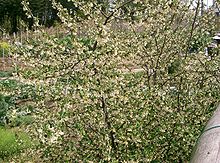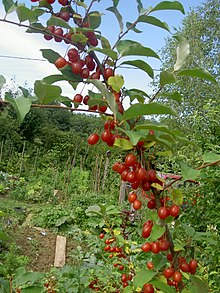Elaeagnus multiflora: Difference between revisions
m Bot: Migrating 2 interwiki links, now provided by Wikidata on d:q2139163 |
Complainer (talk | contribs) rm par: neither the fruit-is-good people nor the sceptical can provide any source, and this kind of debate is sterile. |
||
| Line 21: | Line 21: | ||
As with other species in the genus ''Elaeagnus'', ''E. multiflora'' plants are [[actinorhizal plant|actinorhizal]], growing in [[symbiosis]] with the [[actinobacteria|actinobacterium]] ''[[Frankia]]'' in the soil. These bacteria fix atmospheric [[nitrogen]], making it available in usable form for the host plant, and indirectly for other nearby plants. This feature allows the plant to grow in poorer soils than it could otherwise. |
As with other species in the genus ''Elaeagnus'', ''E. multiflora'' plants are [[actinorhizal plant|actinorhizal]], growing in [[symbiosis]] with the [[actinobacteria|actinobacterium]] ''[[Frankia]]'' in the soil. These bacteria fix atmospheric [[nitrogen]], making it available in usable form for the host plant, and indirectly for other nearby plants. This feature allows the plant to grow in poorer soils than it could otherwise. |
||
[[China|Chinese]] people have traditionally considered ''Elaeagnus multiflora'' to be among a group of "[[nutraceutical]]s", or foods that are edible and have medicinal values. They are said to decrease [[cholesterol]] and have other benefits, but scientific evidence has yet to confirm this belief {{Fact|date=February 2007}}. |
|||
This species is occasionally grown in [[Europe]] and [[North America]] as an [[ornamental plant]] and for its fruit. It is an [[naturalisation (biology)|established exotic species]] in parts of the eastern [[United States]] [http://plants.usda.gov/java/profile?symbol=ELMU]. |
This species is occasionally grown in [[Europe]] and [[North America]] as an [[ornamental plant]] and for its fruit. It is an [[naturalisation (biology)|established exotic species]] in parts of the eastern [[United States]] [http://plants.usda.gov/java/profile?symbol=ELMU]. |
||
Revision as of 12:54, 8 May 2013
This article includes a list of general references, but it lacks sufficient corresponding inline citations. (February 2013) |
| Elaeagnus multiflora | |
|---|---|

| |
| Scientific classification | |
| Kingdom: | |
| (unranked): | |
| (unranked): | |
| (unranked): | |
| Order: | |
| Family: | |
| Genus: | |
| Species: | E. multiflora
|
| Binomial name | |
| Elaeagnus multiflora | |
Elaeagnus multiflora (Goumi, Gumi, Natsugumi, or Cherry silverberry), is a species of Elaeagnus native to China, Korea, and Japan.
Elaeagnus multiflora is a deciduous or semi-evergreen shrub or small tree growing to 2-8 m tall, with a trunk up to 30 cm diameter with dark brown bark. The shoots are densely covered in minute red-brown scales. The leaves are ovate to elliptic, 3-10 cm long and 2-5 cm broad, green above, and silvery to orange-brown below with dense small scales.
The flowers are solitary or in pairs in the leaf axils, fragrant, with a four-lobed pale yellowish-white corolla 1.5 cm long; flowering is in mid-spring.


The fruit is round to oval drupe 1 cm long, silvery-scaled orange, ripening red dotted with silver or brown, pendulous on a 2-3 cm peduncle. When ripe in mid- to late summer, the fruit is juicy and edible, with a sweet but astringent taste somewhat similar to that of rhubarb. The skin of the fruit is thin and fragile, making it difficult to transport, thus reducing its viability as a food crop.
As with other species in the genus Elaeagnus, E. multiflora plants are actinorhizal, growing in symbiosis with the actinobacterium Frankia in the soil. These bacteria fix atmospheric nitrogen, making it available in usable form for the host plant, and indirectly for other nearby plants. This feature allows the plant to grow in poorer soils than it could otherwise.
This species is occasionally grown in Europe and North America as an ornamental plant and for its fruit. It is an established exotic species in parts of the eastern United States [1].
References
- Germplasm Resources Information Network: Elaeagnus multiflora
- Japan Tree Encyclopaedia: Natsugumi (Elaeagnus multiflora)
- Plants for a Future: Elaeagnus multiflora
- USDA Natural Resources Conservation Service: PLANTS Profile for Elaeagnus multiflora (cherry silverberry)
